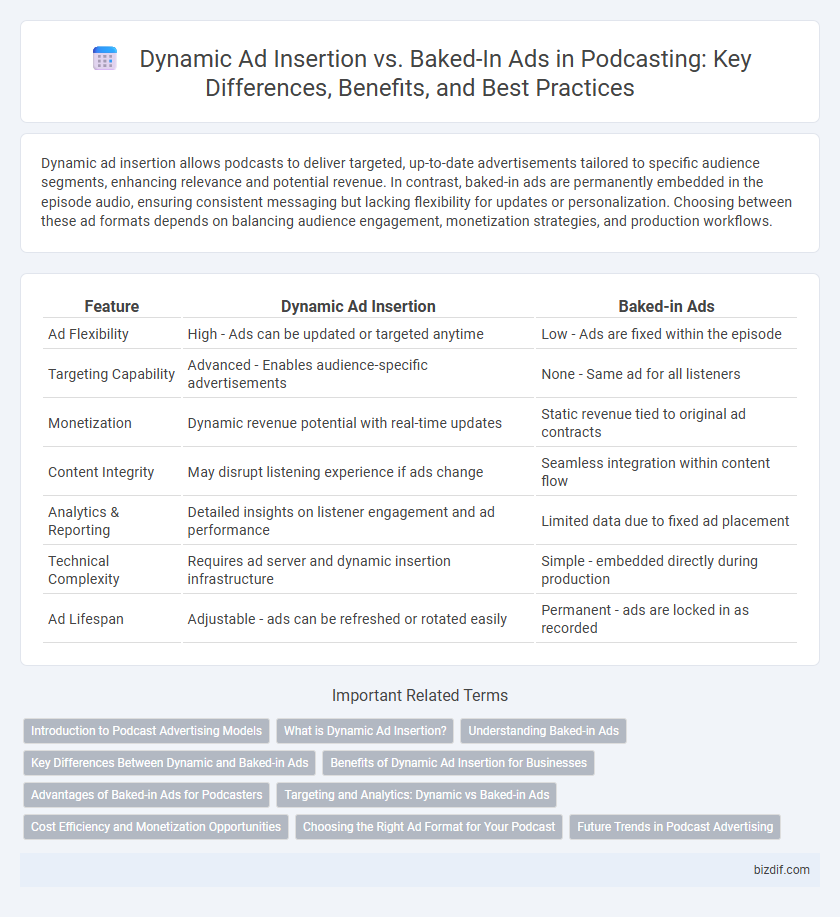Dynamic ad insertion allows podcasts to deliver targeted, up-to-date advertisements tailored to specific audience segments, enhancing relevance and potential revenue. In contrast, baked-in ads are permanently embedded in the episode audio, ensuring consistent messaging but lacking flexibility for updates or personalization. Choosing between these ad formats depends on balancing audience engagement, monetization strategies, and production workflows.
Table of Comparison
| Feature | Dynamic Ad Insertion | Baked-in Ads |
|---|---|---|
| Ad Flexibility | High - Ads can be updated or targeted anytime | Low - Ads are fixed within the episode |
| Targeting Capability | Advanced - Enables audience-specific advertisements | None - Same ad for all listeners |
| Monetization | Dynamic revenue potential with real-time updates | Static revenue tied to original ad contracts |
| Content Integrity | May disrupt listening experience if ads change | Seamless integration within content flow |
| Analytics & Reporting | Detailed insights on listener engagement and ad performance | Limited data due to fixed ad placement |
| Technical Complexity | Requires ad server and dynamic insertion infrastructure | Simple - embedded directly during production |
| Ad Lifespan | Adjustable - ads can be refreshed or rotated easily | Permanent - ads are locked in as recorded |
Introduction to Podcast Advertising Models
Dynamic ad insertion allows for real-time targeting and seamless ad updates across episodes, enhancing listener relevance and advertiser flexibility. Baked-in ads, embedded directly into podcast episodes, ensure consistent messaging but lack the ability to adapt over time or target specific listener demographics. Choosing between these models depends on campaign goals, budget, and the desired level of personalization and longevity in advertising impact.
What is Dynamic Ad Insertion?
Dynamic Ad Insertion (DAI) is a technology that allows podcast advertisers to deliver targeted and customizable ads in real-time, tailoring messages based on listener demographics, location, or behavior. Unlike baked-in ads embedded in the original recording, DAI enables ads to be updated, replaced, or rotated after publication, increasing relevance and maximizing monetization opportunities. This method supports advanced analytics and campaign optimization by tracking listener engagement and ad performance dynamically.
Understanding Baked-in Ads
Baked-in ads are pre-recorded advertisements permanently embedded within podcast episodes, ensuring consistent ad delivery regardless of when or where the episode is played. This format allows podcasters to maintain creative control over ad placement and guarantees that sponsors' messages remain intact over time. However, baked-in ads lack the flexibility of dynamic ad insertion, which can limit targeting and real-time updating capabilities.
Key Differences Between Dynamic and Baked-in Ads
Dynamic ad insertion allows real-time placement of targeted advertisements based on listener data, enhancing relevance and engagement, while baked-in ads are permanently embedded within the podcast audio, limiting flexibility. Dynamic ads enable advertisers to update content, track impressions, and optimize campaigns efficiently, whereas baked-in ads provide consistent messaging but cannot be modified after publishing. The choice between dynamic and baked-in ads impacts ad personalization, measurement accuracy, and content lifespan in podcast monetization strategies.
Benefits of Dynamic Ad Insertion for Businesses
Dynamic ad insertion offers businesses flexible targeting capabilities, enabling real-time customization of ads based on listener demographics and behavior. This method enhances ad relevance and engagement, driving higher conversion rates compared to fixed, baked-in ads. Moreover, dynamic ads provide measurable performance metrics and easy updates, allowing marketers to optimize campaigns quickly and maximize return on investment.
Advantages of Baked-in Ads for Podcasters
Baked-in ads in podcasting provide consistent listener experience by integrating sponsorship messages directly into the episode content, ensuring seamless delivery even without internet connectivity. This approach fosters stronger brand recall and trust as ads remain permanently embedded, preventing ad skipping and replay issues common with dynamic ad insertion. Podcasters benefit from greater creative control and the ability to tailor ads precisely to episode tone and style, enhancing overall audience engagement.
Targeting and Analytics: Dynamic vs Baked-in Ads
Dynamic ad insertion enables precise targeting by delivering personalized ads based on listener demographics, location, and behavior, resulting in higher engagement and conversion rates. Enhanced analytics provide real-time data on ad performance, listener interactions, and campaign effectiveness, allowing advertisers to optimize their strategies swiftly. In contrast, baked-in ads are static, offering limited targeting capabilities and delayed analytics, which restricts adaptability and detailed audience insights.
Cost Efficiency and Monetization Opportunities
Dynamic ad insertion offers superior cost efficiency by allowing real-time ad targeting and easy updates without re-editing episodes, maximizing monetization opportunities through tailored campaigns and higher advertiser demand. Baked-in ads, while cheaper upfront due to fixed placement, limit flexibility and long-term revenue potential as advertisers seek dynamic, data-driven ad placements. Podcasts leveraging dynamic ads benefit from scalable advertising strategies and optimized listener engagement, enhancing overall profitability.
Choosing the Right Ad Format for Your Podcast
Dynamic Ad Insertion offers flexibility by allowing advertisers to update podcast ads in real-time, targeting specific audience segments and seasons, which enhances relevancy and potential revenue. Baked-in Ads create a seamless listening experience with ads permanently embedded in episodes, ensuring consistent messaging but limiting adaptability and scalability. Selecting the right ad format depends on factors like audience engagement goals, production timeline, and monetization strategy to maximize both listener retention and advertising effectiveness.
Future Trends in Podcast Advertising
Dynamic ad insertion leverages real-time data to deliver personalized ads tailored to listener preferences, boosting engagement and advertiser ROI. Baked-in ads remain static but offer seamless integration within content, often preferred for branding consistency and timeless messaging. Future trends highlight increased adoption of AI-driven targeting and measurement technologies, blending dynamic flexibility with creative authenticity to maximize podcast advertising impact.
Dynamic Ad Insertion vs Baked-in Ads Infographic

 bizdif.com
bizdif.com